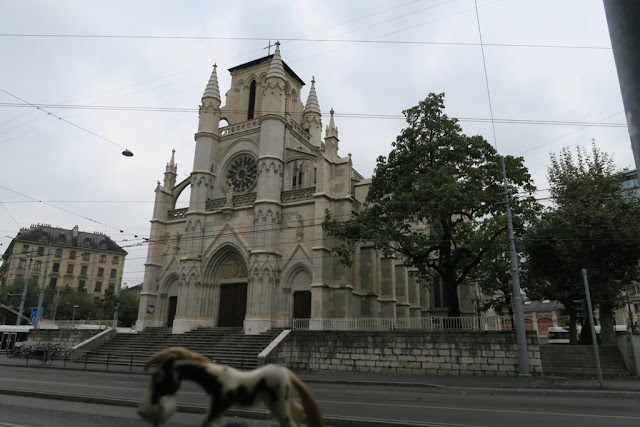We have come to the top of Pilatus with the cable car. We will go down from the opposite side of the mountain, using the Pilatus Cogwheel Railway. We will take this nice red train ...
... and go down through this nice tunnel (and many others).
If you wonder what "cogwheel railway" means I will show you - this is a train that uses cogs to hold to its way. Obviously the railway is different from the ones you usually see when travelling between cities. But it also differs form other cogwheel railways, because the cogwheels are mounted horizontally not to let the train slip when the rail is over 45 degrees steep.
The Pilatus Cogway Railway is the steepest of this type in the world. Its inclination goes up to 48%, with an average of 35%.
The reason why the railway needs to be so steep is that Mount Pilatus is steep itself.
Yes, yes, you saw it right. There are people who go down on foot. Just three hours and a half says the guide. Around six hours if you wish to go up. Good luck to whose who try.
Honestly speaking I am not sure where to keep my focus. On the amazing alpine views ...
... or on the amazing trail we are on. Put your heads back to the train, we are approaching yet another tunnel!
The railway includes several small trains. We are likely to meet many of them just in front ...
... or behind us.
The tunnels are luckily short, you can see here that one of them ends just after it has began.
Thanks to it we can admire those amazing rocks. Have you noticed the multi-shade layers? I bet they used to be horizontal but the force of the tectonic plates on the move has made them vertical.
We are now mid-way, in a place where the trains in opposite directions can pass each other. Now everybody waves!
The water you could spot in the back is Lake Lucerne that we have seen from the top of Mount Pilatus last week.
The trail is still steep.
And so are the surrounding rocks. This one looks as if a giant would cut it with a huge knife.
Finally, we are getting closer to see (or rather - lake) level. Blue, green, red, the magic of nature at its best.
Last glimpse from the window (do not lean out!).
Those of you who wish to continue their journey with a boat will find the marina on their left hand side.
So we have finally arrived. But look, there is no place for the train to turn around.
I am sure that you wonder how they will make the train go back. Will it jump to the other rail? Well, not. The rail will come to it.
And then, the train will move sideways. Notice like the pantograph goes up to reach the electrical lines. At the begining the Pilatus Cogway Railway was powered with steam. Today it uses of course electricity.
I hope that you have enjoyed our ride on the Pilatus Cogway Railway.
Looking at the lower station and the little hill behind it I would not have guessed that a ride on this nice train would be almost like flying on a dragon.






































































